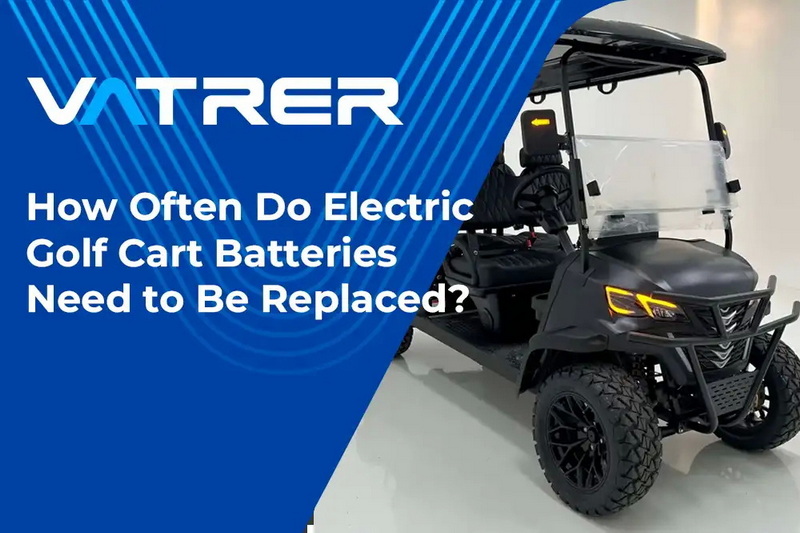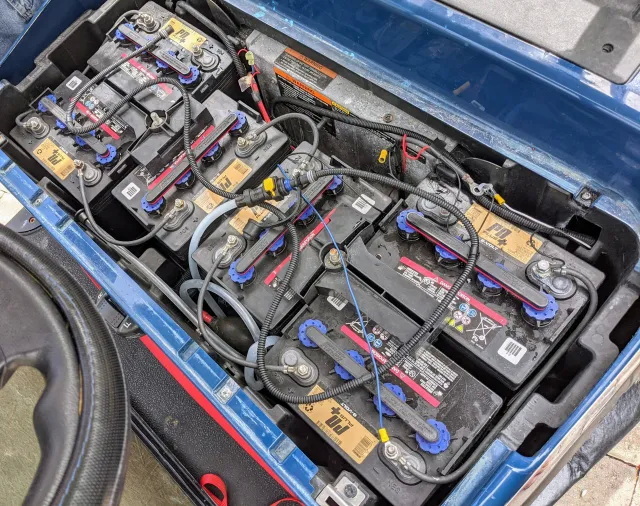Content Menu
● Types of Golf Cart Batteries
>> Lead-Acid Batteries
>> Lithium-Ion Batteries
● Factors Affecting Battery Lifespan
>> Usage Frequency
>> Driving Style
>> Charging Practices
● Maintenance Tips for Prolonging Battery Life
>> Regular Inspection
>> Proper Charging Habits
>> Water Levels (for Lead-Acid Batteries)
● Signs Your Golf Cart Battery Needs Replacement
● Conclusion
● Frequently Asked Questions
>> 1. How often should I charge my golf cart batteries?
>> 2. What is deep discharging?
>> 3. How can I tell if my golf cart battery needs replacing?
>> 4. Can I use my golf cart in extreme temperatures?
>> 5. What type of charger should I use for my golf cart?
Electric golf carts have become increasingly popular for both recreational and practical uses, providing a convenient way to navigate golf courses, communities, and other venues. At the heart of these electric vehicles lies the battery, which plays a crucial role in determining how long the cart can operate on a single charge. Understanding the lifespan of golf cart batteries, the factors that influence their longevity, and how to maintain them can significantly enhance your experience as a golf cart owner.

Types of Golf Cart Batteries
When it comes to electric golf carts, there are primarily two types of batteries used: lead-acid batteries and lithium-ion batteries. Each type has its own advantages and disadvantages.
Lead-Acid Batteries
Lead-acid batteries are the traditional choice for many golf carts. They are known for their affordability and reliability but generally have a shorter lifespan compared to lithium-ion batteries.
- Flooded Lead-Acid Batteries: These require regular maintenance, including checking water levels and cleaning terminals. They typically last around 3 to 5 years with proper care.
- AGM (Absorbed Glass Mat) Batteries: AGM batteries are sealed and do not require regular maintenance. They can last approximately 4 to 6 years but are usually more expensive than flooded lead-acid options.
Lithium-Ion Batteries
Lithium-ion batteries have gained popularity due to their longer lifespan and lower maintenance requirements.
- They can last anywhere from 6 to 10 years or even longer, depending on usage and care.
- Lithium-ion batteries are also lighter and charge faster than lead-acid batteries, making them a more efficient choice for many users.
Factors Affecting Battery Lifespan
Several factors influence how long an electric golf cart battery will last:
Usage Frequency
The frequency with which you use your golf cart significantly impacts battery life.
- Daily Use: If you use your cart daily, expect a lifespan of about 1 to 3 years for lead-acid batteries, while lithium-ion may last longer due to their ability to handle frequent charging cycles better.
- Occasional Use: For those who use their carts less frequently, lead-acid batteries may last up to 5 years or more, while lithium-ion can still reach the upper limits of their lifespan.
Driving Style
Your driving habits can also affect battery health.
- Sudden acceleration and hard braking consume more energy and generate heat, which can damage battery cells over time.
- A smoother driving style helps conserve energy and can extend battery life.
Charging Practices
Proper charging is essential for maximizing battery lifespan.
- Always charge your battery after each use, even if you only drove it for a short distance.
- Avoid letting the battery discharge completely; deep discharges can severely shorten its lifespan.

Maintenance Tips for Prolonging Battery Life
To ensure your golf cart battery lasts as long as possible, follow these maintenance tips:
Regular Inspection
- Check for corrosion on terminals and clean them regularly with a mixture of baking soda and water.
- Inspect the battery case for any signs of damage or leaks.
Proper Charging Habits
- Use a quality charger specifically designed for your type of battery.
- Avoid overcharging; most modern chargers will automatically stop charging when the battery is full.
Water Levels (for Lead-Acid Batteries)
- Regularly check water levels in flooded lead-acid batteries and top them up with distilled water as needed.
Signs Your Golf Cart Battery Needs Replacement
Recognizing when your golf cart battery is nearing the end of its life is crucial for avoiding unexpected breakdowns. Here are some signs to look out for:
- Decreased Run Time: If you notice that your golf cart runs shorter distances on a full charge than it used to, it may be time to replace the battery.
- Difficulty Holding Charge: If your battery drains quickly or struggles to hold a charge, it could indicate deterioration.
- Visible Damage: Look for swelling or leaks in the battery casing; these are clear signs that replacement is necessary.
Conclusion
In conclusion, the lifespan of an electric golf cart battery varies based on several factors including type, usage frequency, driving style, and maintenance practices. While lead-acid batteries typically last between 3 to 6 years, lithium-ion batteries can offer a much longer service life of up to 10 years or more with proper care. By understanding these factors and implementing good maintenance practices, you can maximize the performance and longevity of your golf cart's battery.

Frequently Asked Questions
1. How often should I charge my golf cart batteries?
Charge your golf cart batteries after every use. If you use your cart infrequently, aim to charge it at least once every month to prevent self-discharge.
2. What is deep discharging?
Deep discharging refers to allowing your battery's charge level to drop too low (typically below 20%). This practice can damage the cells and significantly shorten the lifespan of both lead-acid and lithium-ion batteries.
3. How can I tell if my golf cart battery needs replacing?
Signs include decreased run time on a full charge, difficulty holding a charge, visible damage such as swelling or leaks, and excessive water consumption in lead-acid batteries.
4. Can I use my golf cart in extreme temperatures?
Extreme temperatures can negatively affect battery performance. It's best to store your golf cart in a climate-controlled environment when not in use.
5. What type of charger should I use for my golf cart?
Always use a charger specifically designed for your type of golf cart battery (lead-acid or lithium-ion) to ensure optimal charging efficiency and safety.










































